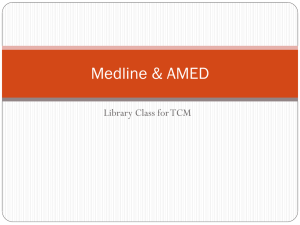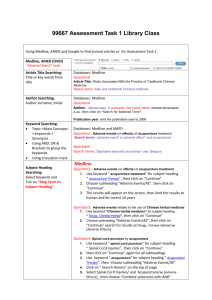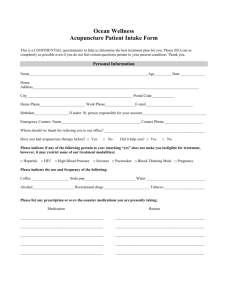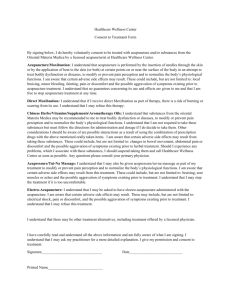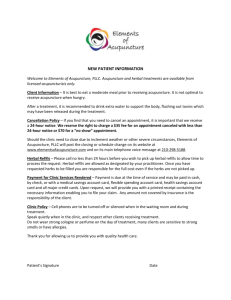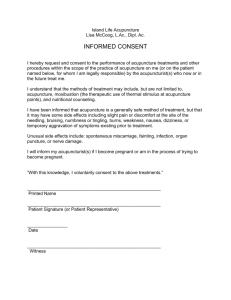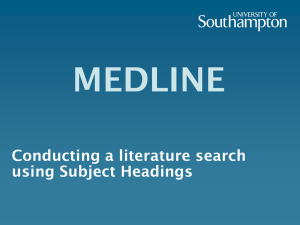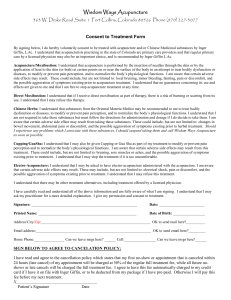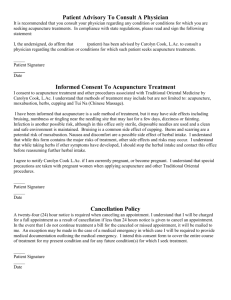99667 Clinical Theory and Clinic Level 1
advertisement
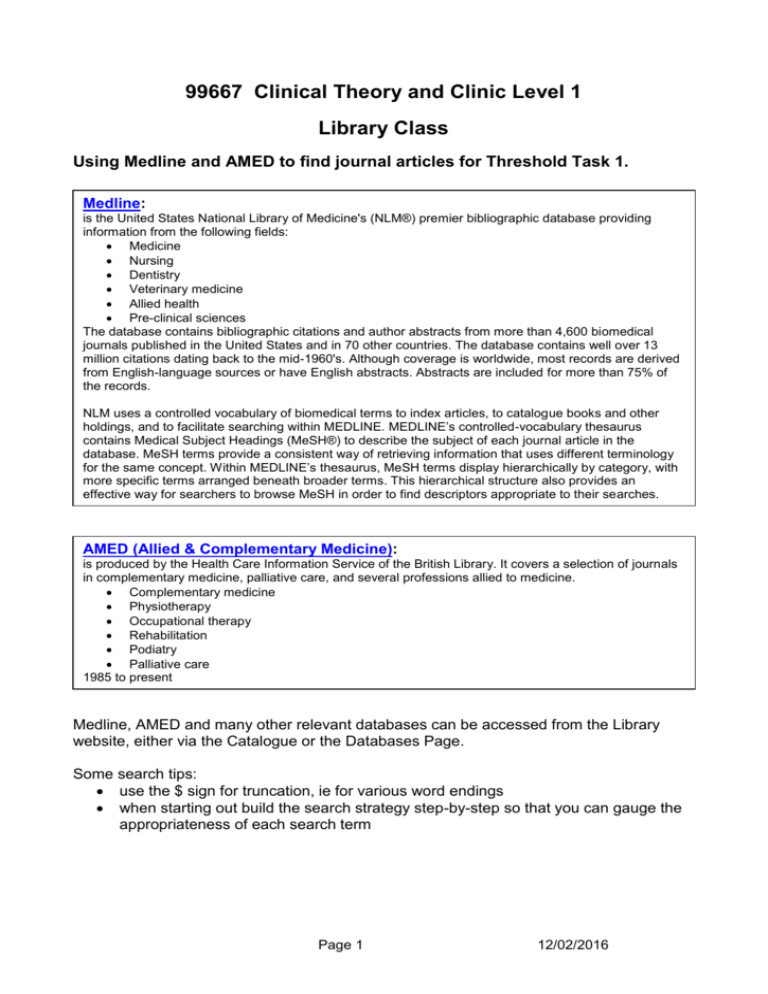
99667 Clinical Theory and Clinic Level 1 Library Class Using Medline and AMED to find journal articles for Threshold Task 1. Medline: is the United States National Library of Medicine's (NLM®) premier bibliographic database providing information from the following fields: Medicine Nursing Dentistry Veterinary medicine Allied health Pre-clinical sciences The database contains bibliographic citations and author abstracts from more than 4,600 biomedical journals published in the United States and in 70 other countries. The database contains well over 13 million citations dating back to the mid-1960's. Although coverage is worldwide, most records are derived from English-language sources or have English abstracts. Abstracts are included for more than 75% of the records. NLM uses a controlled vocabulary of biomedical terms to index articles, to catalogue books and other holdings, and to facilitate searching within MEDLINE. MEDLINE’s controlled-vocabulary thesaurus contains Medical Subject Headings (MeSH®) to describe the subject of each journal article in the database. MeSH terms provide a consistent way of retrieving information that uses different terminology for the same concept. Within MEDLINE’s thesaurus, MeSH terms display hierarchically by category, with more specific terms arranged beneath broader terms. This hierarchical structure also provides an effective way for searchers to browse MeSH in order to find descriptors appropriate to their searches. AMED (Allied & Complementary Medicine): is produced by the Health Care Information Service of the British Library. It covers a selection of journals in complementary medicine, palliative care, and several professions allied to medicine. Complementary medicine Physiotherapy Occupational therapy Rehabilitation Podiatry Palliative care 1985 to present Medline, AMED and many other relevant databases can be accessed from the Library website, either via the Catalogue or the Databases Page. Some search tips: use the $ sign for truncation, ie for various word endings when starting out build the search strategy step-by-step so that you can gauge the appropriateness of each search term Page 1 12/02/2016 For example, in Question 2 of the Threshold Task we are asked to find papers relating to acupuncture and adverse events (or effects). A reasonable search strategy would be: acupuncture AND (adverse events or adverse effects) in Medline this translates into the following search result: Note that many of the resulting papers are not that relevant. They may mention acupuncture and they may mention adverse effects but not necessarily in the way we want. Subject Headings Using keyword searching often works well but sometimes a much more precise search can be done using Subject Headings. Medline uses a system of subject headings called MESH. One strategy is to browse the list of papers found using a keyword search and examine the Subject Headings contained in the most relevant papers. Click on a Subject Heading to do a search for papers on that subject. For Question 2 the following Subject Heading looks promising: Acupuncture Therapy / ae [Adverse Effects] This is actually a Heading and a subheading. Another strategy is to search using Subject Headings directly. Page 2 12/02/2016 Let’s try this in Question 3, tick the box for Map Term to Subject Heading then search for the phrase Chinese herbal medicine. This will retrieve a list of subject headings contained in the papers that you would have retrieved using that search. In effect this tells you what the preferred subject headings are for the term you entered. Click on the Scope notes to investigate the meanings of the headings. Choose the first one and click continue. Have a look through the subheadings available and especially ‘Adverse Effects’ . This is a much more precise search than the one using keywords. Another tip: use Limits Page 3 12/02/2016 Medline contains some full text but not that much. Use the Full Text box to find it. But don’t forget that SFX links will try to find the full text in other databases we subscribe to. Review articles summarise the research findings from many papers and can be very useful for students or others looking for an introduction into a field of research. Search strategies of all questions from Threshold Task 1 1. Locate the document Overview: Adverse Events of Acupuncture in the acupuncture journal located at the website www.medicalacupuncture.org. The article defines an adverse event as: Search strategy: go to the website, and search by key word “adverse events” 2. Search the journal databases (AMED, Medline) and find three separate papers that make mention of adverse events (or effects) and acupuncture treatment. List the documented adverse event(s) and provide reference details. (Include first author, journal, year, volume, issue and page numbers. For example: King E et al. Acupuncture in Medicine 2002;20(4):150-9. This is so I can locate the abstract for marking purposes). Search strategy: use “Advanced Search” in Medline (Ovid), search by keyword “acupuncture treatment” and tick “Map Term to Subject Heading”, choose “Acupuncture Therapy” then select “/ae - Adverse Effects” and conduct search Tips: Search by keywords “adverse events” and “acupuncture treatment” from Basic Search won’t give you 100% correct results. For a broad topic, use “Map Term to Subject Heading” in Advanced Search will make search more precise. A shortcut way is to type in “Acupuncture Therapy/ae [Adverse Effects]” 3. Search the journal databases and find a minimum of three separate papers, different from those listed in Question 2, that report incidences of adverse events Page 4 12/02/2016 related to the use of Chinese herbal medicine. List the documented adverse event(s). Provide reference details. Search strategy: use “Advanced Search” in Medline, search by keyword “Chinese herbal medicine” and tick “Map Term to Subject Heading”, choose “Drugs, Chinese Herbal” then select “/ae - Adverse Effects” and conduct search Tip: A shortcut way is to type in “Drugs, Chinese Herbal/ae [Adverse Effects]” 4. Provide reference details of a literature source documenting spinal cord puncture by acupuncture. Search strategy: Step1: use “Advanced Search” in Medline, search by keyword “acupuncture treatment” and tick “Map Term to Subject Heading”, tick “Acupuncture Therapy” then select “/ae - Adverse Effects” and conduct search Step2: search by keyword “spinal cord injury” and tick “Map Term to Subject Heading”, choose “ Spinal Cord Injuries” and conduct search Step3: combine search results from Step1 and Step 2 with operator “and” 5. What botanical product was substituted for the Chinese herb Stephania tetrandra resulting in extensive interstitial fibrosis of the kidneys (kidney failure) in about 100 patients in Belgium? Search strategy: use “Basic Search” in Medline, search by keywords “Stephania tetrandra” and “kidney failure” and Belgium and conduct search Tip: “Map Term to Subject Heading” is NOT needed to search a specific literature 6. Locate the article titled Risks Associated With the Practice of Traditional Chinese Medicine: An Australian Study by Bensoussan A, Myers S, Carlton A, published in 2000. Search strategy: use “Advances Search” in Medline, search by Title “Associated With the Practice of Traditional Chinese Medicine” and conduct search 7. Locate the abstract of a study conducted by AJ Norheim published in 1994 on the complications of acupuncture therapy. Search strategy: use “Advances Search” in Medline, search by Author “Norheim, AJ” and conduct search, then browse records by date 8. When should Standard Precautions be used? Search strategy: Page 5 12/02/2016 Step1: use “Advanced Search” in Medline, search by keyword “precautions” and tick “Map Term to Subject Heading”, choose “Universal Precautions” and conduct search Step2: search by keyword “acupuncture treatment” and tick “Map Term to Subject Heading”, choose “Acupuncture Therapy” and conduct search Step3: combine search results from Step1 and Step 2 with operator “and” 9. While you were in clinic you witnessed an incident were a needle was removed from a patient and double handled by two students resulting in a needle stick injury. What should the ‘stuck’ student immediately do? Search strategy: use “Advanced Search” in Medline, search by keyword “needle stick injury” and tick “Map Term to Subject Heading”, choose “Needlestick Injuries” and click continue, select “Therapy” and conduct search 10. A patient has phoned the UTS Herbal Clinic in some distress. She was given a new herbal formula by the practitioner for treatment of a chronic skin condition. However, upon arriving home and ingesting the new formula, she noticed an increase in severity of her condition accompanied by shortness of breath. What should you do? Tip: Search adverse effects of the herb(s) from that formula will be useful. More information resources of TCM are available at Library> My Subject Resources > Study Guide > Science > Traditional Chinese Medicine Have a question? Welcome to ask librarians in Science and Technology team: Janet Chelliah John Mueller Patrick Tooth Jane van Balen Jing Li Ashley England Janet.Chelliah@uts.edu.au John.Mueller@uts.edu.au Patrick.Tooth@uts.edu.au Jane.VanBalen@uts.edu.au Jing.Li@uts.edu.au Ashley.England@uts.edu.au Page 6 12/02/2016
